The Middle Paleozoic
The middle Paleozoic (Silurian & Devonian)
440-355MY ago
At the close of the Ordovician period, a mass extinction apparently caused by global cooling triggered by Gondwanan glaciation wiped out most of the warm-water invertebrates. So, the Silurian survivors were mostly cold-adapted animals, either from high latitudes or from deep waters
The result was:
1. Early Silurian seas were populated by a low diversity of animals
2. By the Late Silurian & Devonian, life had recovered from the Late Ordovician crisis, & the marine ecosystems that developed were as complex as those of the Ordovician
Marine Communities: after the Ordovician crisis, the major phyla of the Paleozoic fauna returned, but different families & orders dominated, among these :
1. Brachiopods
2. Bivalves & Gastropods
3. Trilobites
4. Cephalopods
5. Eurypterids “ Sea scorpion”
6. Planktonic Organisms
7. The Fishes
Brachiopods
the thin shelled, relatively flat brachiopods (Orthids & Strophomenids) were greatly reduced in numbers & replaced by the much thicker shells & more robust, elongated, deeper bodies brachiopods
During the Silurian the Pentamerids brachiopods were dominant
During the Devonian Pentamerids declined, & the sea floor was taken over by a different group of brachiopods, the Spirifers, the typical Devonian spirifers had very long hinges & , so resembled a pair of wings
The heyday of spirifers was the Devonian, but it survived until the Jurassic
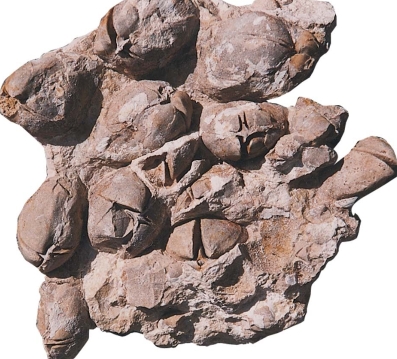

B: Mucrospirifer
C: Syringothyris
Bivalves & Gastropods
Bivalves & Gastropods continued through the Silurian & Devonian Periods, they were more than brachiopods
Bivalves expanded to fresh water habitats for the first time
Trilobites
Middle Paleozoic trilobites were more specialized than found in the Ordovician
Trilobite were relatively scare in the Silurian
Devonian trilobites included the unusual Phacops, which not only could roll up but also had huge compound eyes
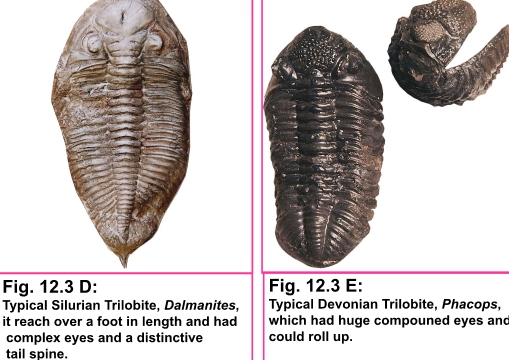
Cephalopods
Nautiloids were declining but they remained one of the major predators in the Silurian
The Nautiloids role as a predator was taken by their descendents the Ammonoids during the Devonian
Ammonoids have a shell that curled into a tight spiral
The suture line in the Nautiloids was a simple curved structure which later it developed into a complex structure (goniatitic) in the Ammonoids, the later suture pattern is typical for late Paleozoic Ammonoids

Eurypterids “ Sea scorpion”
Top predator in Silurian were not Nautiloids or Ammonoids, but the Eurypterids 2.5m length
The eurypterids related to arthropods, ranged through the entire Paleozoic but reached their greatest abundance during the Silurian
Most 13-50cm, but one giant reached 2.5m
Planktonic Organisms
Planktonic organisms also thrived in the warm Silurian & Devonian seas
Acritarchs & Ostracods continued to populate the microplankton as they had since the Cambrian
Graptolites, which were nearly wiped out in the Ordovician extinction, again radiated
Some Silurian graptolites formed either intricate spirals or multiple branches radiating from a single spiral by the late Silurian, free-floating graptolites were in their final decline.
The last known genus Monograptus, the spieces Monograptus uniformis used to recognize the Silurian-devonian boundary
After the end of Silurian, planktonic graptolites become extinct, while the attached bushy type reach the Carboniferous
The Age of Fishes
Simple jaw-less fish had been around for almost 100MY, since the Early Cambrian
During the late Silurian, fish began to diversify, & by the Devonian, they were so abundant in both marine & fresh water deposits that the Devonian is often called “the age of fishes”
Jawless fish continued to be abundant, but during the Silurian, they developed armored head shields and body armor or shield
Placoderms is the typical jawed fish appeared in the Devonian
Jawless fish & the placoderms, not survive the Devonian.
Two other groups of fish that arose in Devonian have living descendants:
1. ray-finned fish, flourished during the late Paleozoic, 99% of the living fishes are from this group
2. lobe-finned fish, have a club-shaped fin supported by stout bones that gave the fin better support; ultimately, this fin allowed the fish to walk on land

Invasion of the Land
Up until the Ordovician, the land had only sparse plant cover, & soils were probably held in place by microbiotic crusts like fungi, bacteria & algae
In Upper Ordovician deposits, there are fossil spores indicating that more advanced plants were present on land
For a semi aquatic plants to thrive on land, several requirements must be met, such as:
1. A water proof cuticle to prevent desiccation in the dray air
2. A strong supporting structure to lift it off the ground because it can no longer depend on the buoyancy of water
3. A means of passing the sperm to the eggs, which are no longer immersed in water
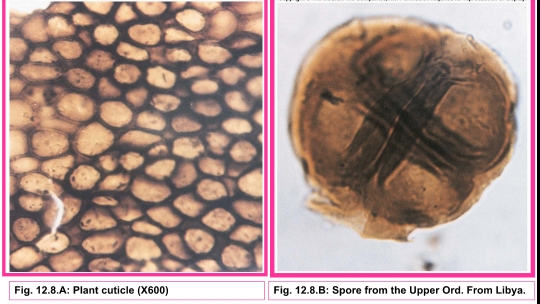
In the Early Silurian
the vascular plants were found, these plants have tubes for transporting water & nutrients through the tissues
In Early Devonian, the known Rhynia plant was discovered in the Rhynie chert formation in Scotland
The Rhynia built of simple, leafless stalks with a water proof cuticle & spore-bearing organs called sporangia at their tips, it reach sometimes to half meter tall
The early Devonian plants lacked roots or leaves & were confined to creeping along the ground
Right a reconstruction of Rhynia & its stem showing the vascular tissue (the central zone of the stem) which was relatively inefficient in conducting fluids, so the stems were seldom more than a few centimeters long
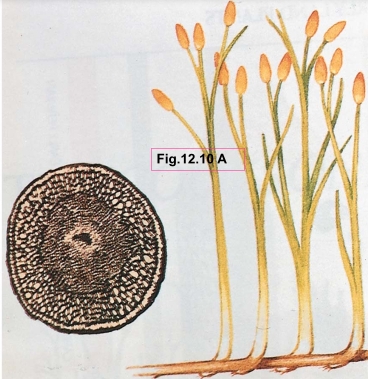
By Middle Devonian time
the vascular bundles in a plant such as Psilophyton occupied a large part of the stem, producing a much stronger stalk & more efficient water transport
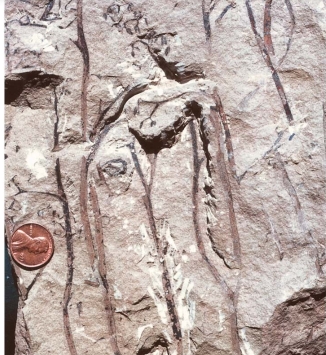
These plants evolved roots, both for support & for removal of nutrients out of the soil and water
Living psilophytes are very similar to their Devonian ancestors
By the late Devonian
Lycopsids including the living “club mosses & ground pine” covered the landscape
Some general features of Lycopsids:
1. growing near water.
2. reached meter or more in height, with some carboniferous lycopsid trees reaching 30 m in height
3. have long, slender leaves issued directly from the trunk in a spiral arrangement
4. more advanced than psilophytes, in place of sporangia lycopsids have separate male cone & female cone
Another spore-bearing group of Devonian plants was the Sphenopsids, or jointed- stemmed plants
general features of Sphenopsids:
1. commonly found along stream banks today.
2. have long, hallow stem that jointed.
3. leaves and sporangia clustered at joints
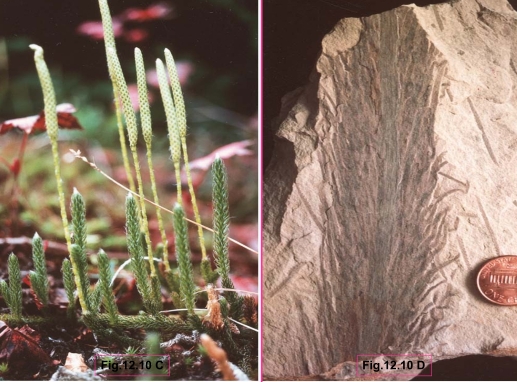
The late Silurian or early Devonian lycopsid Baragwanathia, from Australia
It is one from the oldest known vascular plant fossils
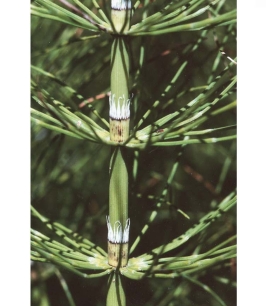
Another Devonian spore bearing plants are the true Fern, which are:
1. abundant today in any shady, damp area.
2. sporangia occur in small clumps under the leaves
3. there are more than 10,000 living species
In the Devonian time they was small plants but large trees in the Carboniferous time

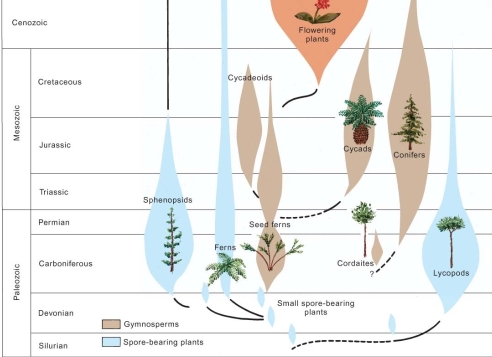
As a result of the plant invasion of the land, a new habitat was created on land, therefore the land was soon exploited by the first land animals, the Arthropods
In the late Ordovician the land was inhabitant by millipede-like animals
The lower Devonian Rhynie Chert of Scotland contains a number of fossils arthropods as scorpion, spider & mites
By the end of Devonian, the swamps were filled with a variety of crawling, burrowing, & even flying arthropods
Also by the end of Devonian, the first amphibians (land/sea animals) appeared on dry land
From animals such as Ichthyostega transition between lobe-finned fish & typical amphibians was inferred
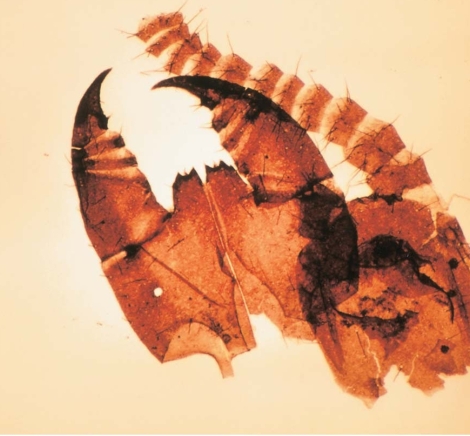
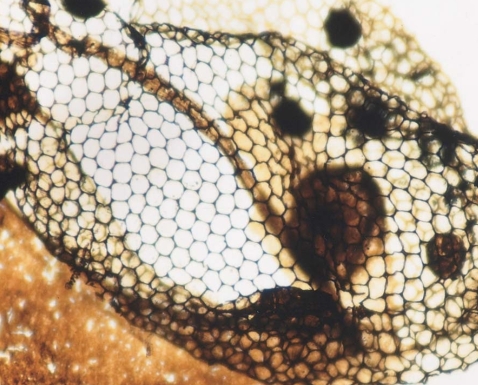

the oldest known land animals, with specimens found in Middle Silurian rocks
This specimen from the late Carboniferous of west Virginia
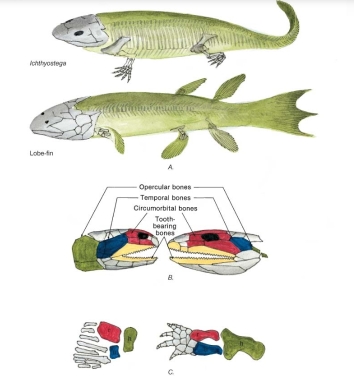
What led vertebrates to struggle into this new, hostile, dry environment, with no water for support?
1. Some scientists have suggested that they did so because their pools dried up & they had to wriggle across land to find another one
2. They left the water because competition & predation from other fish were much greater there, whereas the land represented an unexploited resource: plenty of arthropods to feed upon & no larger predators
Then its not strange to expect a large event that force the organisms to moved to other environments
Late Devonian Mass Extinctions
The last 2 stages of the Devonian are:
– Carboniferous: Famenian & Frasnian
The late Devonian is marked by a severe extinction event, which occurred between the Frasnian & Famenian stages
There is many clues of this extinction
1. In the thick Devonian sequence of New York state, 70% of the marine invertebrate species were wiped out
2. Pentamerids (from Silurian Brachiopods) disappeared completely, 15% of Frasnian brachiopods survived, & ammonoids were devastated
3. Trilobite & Gastropods also declined
4. Tabulate-rugosid-stromatoporid reefs were devastated at the end of Frasnian, & all 3 groups were rare throughout the rest of the Paleozoic
5. The Acritarchs (Microplankton) were almost completely wiped out
6. Most of the typical Devonian fish, including the armored jawless fish & the Placoderms were eliminated

In its place were low-diversity reef built by the cold-water sponge Hydnoceras, suggesting that the Late Devonian extinction was largely caused by global cooling.
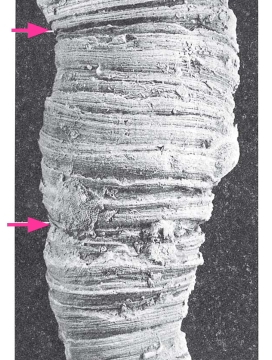
The white lines bracket the annual band, & fine lines between are presumed to be daily growth lines: from evidence such as this Paleontologists have deduced that
the days were shorter (about 22 hours) & the years had more days about (400)
As in case of late Ordovician extinctions, warm-water marine invertebrates were the most hard-hit by the Devonian extinction
By contrast, polar marine organisms in South America were virtually unaffected
All the above factors point to a global cooling event which supported by the presence of glacial deposits in northern Brazil
Paleoclimate & Paleogeography of middle Paleozoic
Abundance of iron oxides & calcium sulfate evaporites in certain Silurian & Devonian sediments indicates a strongly oxidizing atm
The presence of great organic reef complexes & rich, very diverse marine fossils in both Silurian & Devonian marine strata suggests warm, shallow, agitated seas by analogy with modern shallow tropical seas
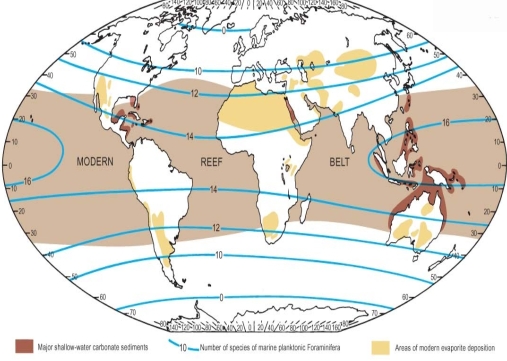
Contours indicating latitudinal diversity (number of species) of modern marine planktonic
Foraminefera as function of temperature.
Devonian land plants are similar the world over, suggesting that climate was essentially uniform
Wide distribution of richly fossiliferous middle Paleozoic marine carbonate rocks, & especially the great latitudinal spread of fossil reef suggest subtropical conditions for North America, Europe, Siberia, & Australia
Devonian evaporites also closely parallel the reefs.
Based upon this reasoning, the average climate of the earth through time probably has been milder & more homogenous than it is today, So the present certainly is not a very good key to the past in terms of climate

